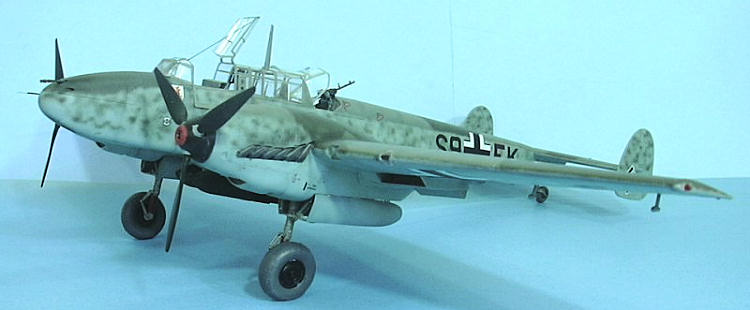
| KIT #: | 3203 |
| PRICE: | $120.00 MSRP |
| DECALS: | Two options |
| REVIEWER: | Tom Cleaver |
| NOTES: |
Do not pursue this project in the presence of small children if
you do not want them learning words you hadn’t planned on teaching them
just yet. |

| HISTORY |
The revolution in aircraft
design that happened in 1934 - the year that saw the Bf-109, Supermarine
Spitfire, Hawker Hurricane and P-36 prototypes begin design - also saw the
commencement of development of a different kind of fighter, the “strategic”
fighter.
Where the single-engine aircraft were primarily seen at the
time as short-range interceptors, this second group were to be long-range
fighters that would escort the coming fleets of bombers and defend them from
the interceptors.
The idea was good, but the execution - which
involved designing multi-engine, multi-seat heavy airplanes - guaranteed
that none of these designs would achieve success in the role they were
originally created to fulfill.
That year, the
Reichluftfartministerium (RLM)issued a request
for proposals for what was called the Kampfzerstörer
(battle destroyer). The request called for a twin-engined, three-seat, all
metal monoplane, armed with cannon as well as a bomb bay. Only three
companies out of seven the proposal was sent to responded, including
Bayerische Flugzeugwerke
(Messerschmitt), Focke-Wulf and Henschel. Messerschmitt’s proposal ignored
most of the Kampfzerstörer
specifications, and stuck to a two-seat fighter without any bomb bay.
Focke-Wulf and Henschel were ordered to build
prototypes of their proposals.
Fortunately, due to pressure by Ernst Udet, the RLM
reconsidered the concept of the Kampfzerstörer
and focused on the Zerstörer
concept, which fitted the Messerschmitt proposal.
As a result, Messerschmitt received an order for a
prototype known as the Bf-110.
The first prototype flew on May 12, 1936, at
Augsburg.
This would become the most famous of the series of “strategic
fighters” the world’s air forces were asking for.
The Bf-110 was not as
maneuverable as hoped, but even powered by two Jumo 210Gs with only 700 h.p.
each, it was appreciably faster than any other known fighter and the Germans
saw it as superior to its potential opponents.
The Bf-110B was ordered into production in 1937,
pending delivery of the more powerful DB 600 series engines.
Development difficulties encountered with the new
engine meant that the definitive Bf-110C series did not enter production
until 1939, just prior to the outbreak of war.
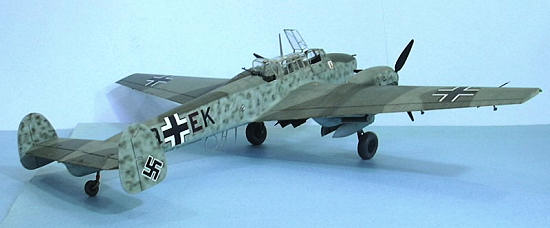 Herman Göring had been
immediately impressed by the Zerstörer
concept, envisioning these airplanes as being the offensive cutting edge of
the Luftwaffe in the war he knew
was coming.
The Zerstörer units
were seen as the elite of the Jagdwaffe,
and were assigned the best pilots.
Herman Göring had been
immediately impressed by the Zerstörer
concept, envisioning these airplanes as being the offensive cutting edge of
the Luftwaffe in the war he knew
was coming.
The Zerstörer units
were seen as the elite of the Jagdwaffe,
and were assigned the best pilots.
The Bf-110C was flown in
limited numbers during the Polish campaign, where the fact that it could not
dogfight single-engine fighters was quickly discovered.
That anyone had ever thought such combat was
possible was amazing.
The airplane was heavy, and even with the DB 601
engine was slow to accelerate and climb, though it could out-dive just about
everything else and had a decent zoom capability.
When the pilots stuck to the vertical plane -
employing dive-and-zoom tactics - they were much more successful.
Future ace Wolfgang Falck led the most successful
unit, I/ZG 76, which claimed 31 kills during the campaign, of which 19 were
confirmed.
The greatest early success of
the Zerstörerwaffe happened on
December 18, 1939, when a formation of 22 RAF Wellington bombers were
spotted off the Heligoland Bight, headed for Wilhelmshaven.
The resulting slaughter of these unescorted bombers
by Bf-110s from Zerstörergeschwader
1 resulted in German claims of 38 bombers shot down, though actual losses
were 11 Wellingtons shot down and 6 damaged to varying degrees.
As a result of “The Battle of the German Bight,” the
RAF abandoned daylight bombing until 1944.
The
Zerstörerwaffe next saw action during
Operation Weserübung, the invasion of Denmark
and Norway. ZG 1 and ZG were committed with 64 aircraft. 25 Danish aircraft
stationed at Væærløse airbase were destroyed by strafing Bf-110s on April 9,
with the one Fokker D.XXI that managed to get airborne being immediately
shot down. During the Danish campaign, Victor Mölders, brother of the famous
Werner Mölders, took the official surrender of the town of Aalborg after he
landed at the local airfield.
German losses in Norway were light, opposed as they
were by obsolete Gloster Gladiators.
On the Western Front, Bf-110s operated by Lehrgeschwader 1 first entered combat with the Armée de l'Air on November 23, 1939, when Bf 110s shot down a Morane-Saulnier M.S.406 over Verdun. As the “Phoney War” continued, several French aircraft were shot down by Bf 110's. On April 2, 1940, I/ZG 1's Gruppenkommandeur, Hauptmann Hannes Gentzen became the highest-scoring Zerstörer pilot in the Luftwaffe, when he added to his score of five by shooting down a Curtiss Hawk 75A-3 over the Argonne forest.
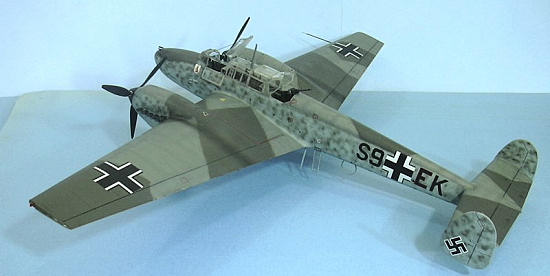 During the campaign in the West
following the German assault on France and the Low Countries on May 10,
1940, the Bf 110 demonstrated its capability as a strike aircraft, with ZG 1
claiming 26 Dutch aircraft destroyed on the ground at Hamstede airfield on
May 10.
However, when the Bf-110s ran up against the RAF in the air
on May 15, their previous success is was tempered by the loss of nine Bf
110s, a sign of times to come over Britain.
With a total loss of 60 Bf-110s, the Western
Campaign demonstrated that the aircraft was vulnerable in hostile skies to
well-flown single-seat fighters like Hurricanes and Spitfires.
During the campaign in the West
following the German assault on France and the Low Countries on May 10,
1940, the Bf 110 demonstrated its capability as a strike aircraft, with ZG 1
claiming 26 Dutch aircraft destroyed on the ground at Hamstede airfield on
May 10.
However, when the Bf-110s ran up against the RAF in the air
on May 15, their previous success is was tempered by the loss of nine Bf
110s, a sign of times to come over Britain.
With a total loss of 60 Bf-110s, the Western
Campaign demonstrated that the aircraft was vulnerable in hostile skies to
well-flown single-seat fighters like Hurricanes and Spitfires.
The success of the
Zerstörerwaffe in the strike role during the
French campaign led to the creation of Erprobungsgruppe
210 at the end of June, for service in the coming
campaign against the Royal Air Force.
Erprobungsgruppe 210 (Erpr.Gr.210):
Erprobungsgruppe 210
was formed on July 1, 1940 at Koln-Ostheim under the command of
Hauptmann Walter Rubensdörffer, a Swiss true
believer in Nazism, who had migrated to Germany following Hitler’s rise to
power and joined the Luftwaffe, where he gained a reputation as a
ground-attack specialist during the Spanish Civil War, where he led 3./J 88
which used the He-51B in the development of
schlactflieger tactics.
The unit was given the task of
operational test of the Bf-109E and Bf-110C as fighter-bombers, and the
development of suitable tactics.
The legend of Erpr.Gr.210
is that the aircrews assigned were all “specialists,” which is not true.
1.Staffel, which was to be equipped
with the new Bf-110C-4/B, a version with a fuselage mounted bomb rack
capable of carrying two SC 500 bombs on a paired ETC 250 rack under the
fuselage,
was formed from I./ZG1.
2.Staffel, also to be equipped
with the Bf-110C-4/B, was formed from
3./StG. 77, and
3.Staffel, which was equipped with the Bf-109E-4B
capable carrying one SC 250 on a centerline rack, was
formed from 4./JG 186. Some crews
were assigned straight in from training, including
Leutnant Erich Beudel and his
Bordfunker,
Obergefreiter Heinrich Diemer, and
Uffz. Werner Neumann and his
Bordfunker,
Obergefreiter Karl Stoff.
At their commissioning,
1.Staffel was equipped with the Bf
11OC-6, only 12 of which were ever built, which carried a 30 mm. MG 101 in
place of the standard two 20 mm cannon. 2.Staffel
received their first Bf-110C-4/B aircraft a week later, while
3.Staffel operated the Bf-109E-4Bs.
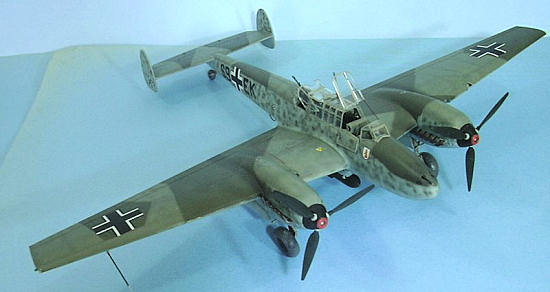 The heavy commitment of the
unit during the Battle of Britain would take its toll: four commanding
officers would be lost in action between August 15th
and October 5th 1940.
An indication of the level of combat experienced by
Erpr.Gr.210 is seen in the fact
that four awards were made of the Knights Cross of the Iron Cross, the most
for any single Gruppe in the
Battle.
The heavy commitment of the
unit during the Battle of Britain would take its toll: four commanding
officers would be lost in action between August 15th
and October 5th 1940.
An indication of the level of combat experienced by
Erpr.Gr.210 is seen in the fact
that four awards were made of the Knights Cross of the Iron Cross, the most
for any single Gruppe in the
Battle.
Erpr.Gr.210 moved
to St. Omer-Arques for missions over the English Channel on July 10, 1940,
and flew its first mission of the Battle of Britain on July 13, 1940,
against two convoys near the mouth of the Thames. No RAF fighters appeared,
and hits were claimed on a total of 20,000 tons of shipping, with all
aircraft returning to France. In the following days the unit continued
attacking convoys, and suffered their first loss on July 24, when the
Bf-110C-4/B of Uffz. Paul
Hermann and his Bordfunker
Uffz. Heinz Meinhardt was hit by AA fire
from the convoy they were attacking and plunged into the North Sea east of
Harwich. 2.Staffel suffered a
second loss on July 27 when the Bf-110C-4/B of Oblt.
Franz Fallenbacher received a direct hit with its bombs still attached and
blew up in mid-air. By the end of July, Erpr.Gr.210
claimed 80,000 tons of British shipping during their two weeks of
operations.
The next few weeks were spent re-equipping 1.Staffel with new Bf-110C-4/B aircraft to replace the Bf-110C-6s, and moving to Calais-Marck airfield for the coming assault on Britain
On August 11, Bf-109E-4Bs of
3.Staffel shot down
barrage balloons protecting Dover Harbor, followed by Bf-110s of
2.Staffel bombing the harbor.
That afternoon, Erpr.Gr.210
sent out after Convoy “Booty” off the coast of Essex, accompanied by Do-17Zs
from KG2, with escort from
I/ZG 26. This was the first time
1.Staffel used Bf-110C-4/Bs, along with two
C-6 strafers. The raiders were able to attack the convoy before being
intercepted by a force of Hurricanes from 17 and 85 Squadrons and Spitfires
from 74 Squadron. In the combat that followed, the two Bf-110C-6s from
1.Staffel were lost.
1./ZG 26 lost two
Bf-110C-3s, while 2./ZG 26 had two damaged in action.
August 12 would prove to be the
busiest day of the Battle of Britain. Erpr.Gr.210
left Calais-Marck at 0930 to attack the radar stations around the south
coast of England. Heading low over the Channel, the unit split into four
formations. Gruppenkommandeur
Rubensdörffer led the four Bf-110C-4/Bs of the
Gruppenstab toward the station in the tiny village of
Dunkirk, north of Canterbury; Oberleutnant.
Otto Hintze led the Bf-109E-4/Bs of 3.Staffel
to the Dover station; Oberleutnant.
Wilhelm-Richard Rossiger led 2.Staffel’s
Bf-110s towards Rye, with
Oberleutnant Martin Lutz leading
1.Staffel’s Bf-110s to
the Pevensey station. All four stations were hit, but the masts were not
toppled.
All except Dunkirk were temporarily put out of action, but
all were back in operation before the end of the day. All aircraft of
Erpr.Gr.210 returned to
Calais-Marck. So far, the tactic of using the fast Bf-110 at low altitude,
operating below the radar screen, was proving effective.
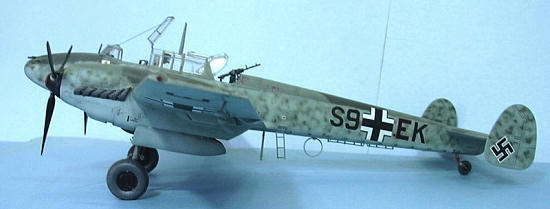 An hour after their return to
Calais-Marck, Erpr.Gr.210
headed for Manston, on the south-eastern tip of
Kent, joined by Dornier 17s of KG2.
Coming in under the radar, the formation made its
approach unopposed. 65 Squadron managed to take off as the raid was in
progress. Heading home, Erpr.Gr.210
was attacked
by 54 Squadron Spitfires and Hurricanes of 501 Squadron. One
Bf-110C-4/B of 1.Staffel
was slightly damaged.
An hour after their return to
Calais-Marck, Erpr.Gr.210
headed for Manston, on the south-eastern tip of
Kent, joined by Dornier 17s of KG2.
Coming in under the radar, the formation made its
approach unopposed. 65 Squadron managed to take off as the raid was in
progress. Heading home, Erpr.Gr.210
was attacked
by 54 Squadron Spitfires and Hurricanes of 501 Squadron. One
Bf-110C-4/B of 1.Staffel
was slightly damaged.
The third mission of the day
came three hours later, when Erpr.Gr.210
hit Hawkinge airfield with a precision attack. Although considerable damage
was done to the airfield, it was not put out of action. All aircraft of the
unit returned to Calais-Marck, ending the most successful day in the history
of Erpr.Gr.210.
Bad weather on August 14
limited the unit to a second attack on Manston.
August 15, which dawned clear, would turn out to be
the day remembered by the Luftwaffe
as “Black Thursday,” and the darkest in the history of
Erpr.Gr.210.
That afternoon, the unit left Calais-Marck to attack Martlesham Heath airfield in Suffolk. Unescorted, they flew in over the North Sea and reached the target unopposed, though Hurricanes of 1 and 17 Squadrons had been scrambled to intercept. The Bf-110s hit the airfield, and damage was compounded by a direct hit on a Fairey Battle loaded with bombs. As the Messerschmitts turned for home, the Hurricanes finally made contact, but this time the losses were all on the RAF side, with three Hurricanes of 1 Squadron shot down and one from 17 Squadron crash-landed. One Bf-110 received sufficient damage it was not serviceable to fly on any other missions that day.
At 1820, Rubensdörffer led the
Gruppenstab and all three
Staffeln on a raid against Kenley airfield,
with JG 52 providing Bf-109s for
escort. Over the Channel, one Bf-110 from 2.Staffel
turned back due to mechanical problems, leaving 14 Bf-110C-4/Bs
of the Stab
and 1. And
2.Staffeln and the eight Bf-109E-4/Bs of 3.Staffel.
On the way in, the escort became detached and turned back.
Erprobungsgruppe 210 continued on alone.
As he approached the target
over Seven Oaks, for some reason Rubensdörffer lined up dived to attack
Croydon, not Kenley, just as the last Hurricanes of 111 Squadron lifted off
from Croydon, while 32 Squadron was scrambled from nearby Biggin Hill.
Croydon, the pre-war civil
airport for London, was inside the line of Greater London that the Luftwaffe
was prohibited from attacking at this time. While the airfield was now used
by the RAF, it was considered off-limits.
Erprobungsgruppe 210 sighted
the Hurricanes climbing out of Biggin and Kenley as Rubensdörffer led the
unit down on Croydon.
The field was hit hard, and as the t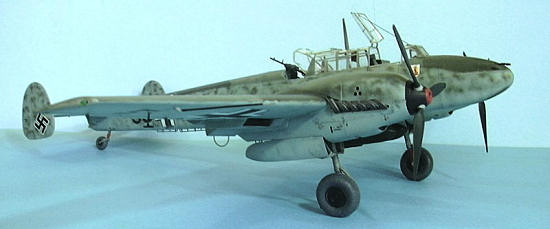 hree
staffeln came off the target and set about
climbing to re-group and head for home, they knew that two enemy squadrons
were in pursuit.
Both RAF squadrons hit the Germans as they attempted
to reform, and the Bf-110s formed “defense circles” for several minutes, but
upon breaking for home the losses started.
hree
staffeln came off the target and set about
climbing to re-group and head for home, they knew that two enemy squadrons
were in pursuit.
Both RAF squadrons hit the Germans as they attempted
to reform, and the Bf-110s formed “defense circles” for several minutes, but
upon breaking for home the losses started.
The four Bf-110s of the
Gruppenstab came under attack by
111 Squadron. Rubensdörffer was hit but the Bf-110 kept flying.
Taking the airplane so low that he was maneuvering
around farm houses, Rubensdörffer streaked for the coast.
A Hurricane managed to get within range as the 110
lifted slightly to go over a church steeple and set the fleeing German
afire. Moments later, as the flames engulfed a wing, Rubensdörffer and his
Bordfunker,
Obergefreiter Richard Kretcher were killed in
the explosion as they hit ground just short of a farmhouse. At almost the
same time Gruppenadjutant Oberleutnant
Horst Redler was shot down.
He died three days later of his wounds while his
Bordfunker,
Obergefreiter Johann Werner became a POW. Hit
badly, Gruppe Technicsoffizier Leutnant
Karl-Heinz Koch made a successful belly-landing, both he and
Bordfunker Unteroffizier
Rolf Kahl being captured. Three more Bf-110’s of
1.Staffel were shot down.
Leutnant Horst Marx, who tried to
help Rubensdörffer, was shot down by a Hurricane and abandoned his
Bf-109E-4/B to become a POW. 2.Staffel
lost two Bf-110’s,
with three of the four crew being captured. The two RAF squadrons suffered
no losses in the action.
Even without the leadership of
Rubensdörffer, Erprobungsgruppe 210
continued to make daring low-level attacks through the remainder of the
Battle of Britain, taking losses that were never so bad as they were on
“Black Thursday,” though the unit lost three more commanding officers.
Following the great battle of September 15, operations tailed off until
September 24, when Erpr.Gr.210
again set out for their third attack on the Spitfire works in Southampton.
Once again, they failed to hit this target, and took
their final loss of the battle, a Bf-110C-4/B shot down into the Channel.
In a raid against the Parnall
Aircraft Factory near Bristol on September 27,
Erpr.Gr.210 could only put up ten Bf-110’s for the
raid when the Gruppenstab,
1. and 2.Staffeln
should normally have been able muster twice that many, an indication of the
state of things in Zerstörer units
by this stage of the Battle.
Escorted by III/JG 26, the Germans were intercepted
by RAF squadrons before they could reach the target.
As they turned and fled south, four aircraft were
shot down, including the third Gruppenkommandeur,
Hauptmann. Martin Lutz, a
Condor Legion veteran, who was killed when his Bf-110C-4/B crashed.
The unit
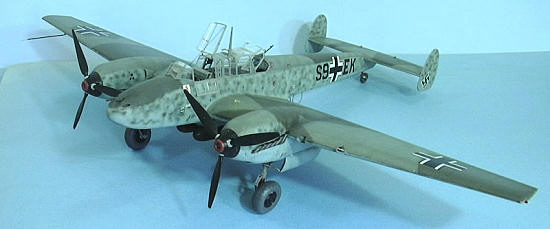 also lost the
Staffelkapitän of 2.Staffel,
Oblt. Wilhelm-Richard
Rossiger. ZG 26 lost six aircraft.
also lost the
Staffelkapitän of 2.Staffel,
Oblt. Wilhelm-Richard
Rossiger. ZG 26 lost six aircraft.
Erpr.Gr.210 flew a
mission to London on October 29th
losing the Bf-110 flown by Feldwebel
Siegfried Troppl, who died with his
Bordfunker, Unteroffizier
Otto Buttner when they crashed back in France. This was the final loss of
what was later known as the Battle of Britain.
On November 15,
Erpr.Gr.210 became
SchnellKampfGeschwader 210 and reverted to shipping
strikes. Having lost four Gruppenkommandeure,
command was taken by Major Wolfgang Schenck, who would take the unit to the
Eastern Front in 1941 and rise to prominence when SKG 210 became ZG 1 on the
Russian Front.
He would later command “Kommando Schenck” to
evaluate the Me-262 as a fighter-bomber and become
Geschwaderkommodore of KG51 on the Me-262A-2a at
the end of the war.
Had more units of the Zerstörerwaffe been employed in the strike role like Erpr.Gr.210, particularly during the airfield attacks in August, the outcome of the Battle of Britain might have been different, since a speeding Bf-110 at low altitude was a very difficult catch for a Hurricane or Spitfire without a lot of luck being involved, as happened on August 15.
| THE KIT |
Dragon’s Bf-110C-7 is the first
large-scale Bf-110 since Revell released theirs in the early 1970s.
The kit is state-of-the-art in terms of mold quality
and detail provided.
As regards it being a
Bf-110C-7, the C-7 sub-type was the first designed-for-the-purpose
fighter-bomber with outboard bomb racks for two 100 Kg bombs under each
wing.
The C-7 is actually the second fighter-bomber version, and could be
distinguished by being fitted with ETC 500 racks that allowed a two 500Kg
bombs to be carried.
The C-7 appeared toward the latter stages of
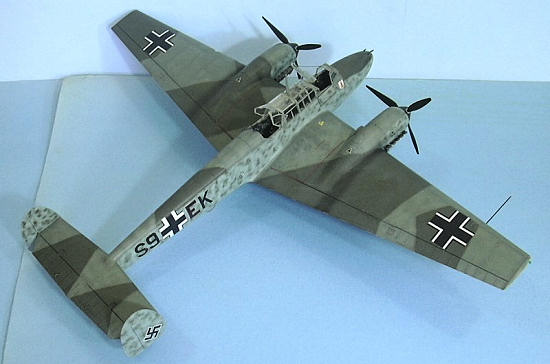 the
Battle of Britain and was not built in large numbers.
the
Battle of Britain and was not built in large numbers.
The good news here is that it
is not hard to do any Bf-110C series airplane, since most of the changes in
sub-types had to do with things that were not visually noticeable
externally.
The really unfortunate thing is
that the decals are almost totally worthless.
The national insignias are the wrong size for a
C-series airplane, there is no swastika, and there are no stencils.
About the only good thing is the individual
lettering and insignia.
The good news here is that
Eagle Editions has a series of decals out for the Bf-110 that include
several versions of the C-series.
These have everything right, including stencils.
An alternative is to use the decals from the most recent release of the old Revell kit. The bad news here - and I speak from experience - is that the decals are not very good, being thick, and pretty impenetrable to even Solvaset. The Eagle Cals are $20 for a sheet that includes individual markings for three airplanes plus appropriate national insignia and stencils, which is a bargain in 1/32. After my experience trying to “cheap out” with the old Revell decals, I recommend these by Eagle Cals without reservation.
| CONSTRUCTION |
Overall, this kit is an
ill-fitting pain in the posterior which, if you persist with it, will turn
into a very good-looking model in the end.
The trick with this kit is to test fit everything
three times before gluing once.
While it appears to be a state-of-the-art kit, it is
really a limited-run kit with state-of-the-art molding of parts, though not
accurate state-of-the-art molding of too many parts. You get better fit from
most MPM kits.
The three places where things are particularly bad are the cockpit and the two engine nacelles.
Getting the cockpit into the
fuselage and successfully closing it up is an event that can turn the
atmosphere over the work bench a deep shade of royal purple, complete with
rolling thunder and lightning flashes.
As to the two engine cowlings, do not waste time
building the engines and installing them, unless you are planning to display
the model with the cowlings off.
As with many kits that have features like open
engines or dropped flaps, the model is really designed for the engine
cowling to be open.
The instructions for this kit
are particularly frustrating.
They would have you build the entire cockpit, then
glue it into the fuselage.
DO NOT DO THIS!
Instead, glue the cockpit side walls to each
fuselage in turn (the locating pins are very helpful), making sure each wall
is tightly in position along the upper edge, which will then allow you to
position the upper decking correctly later.
Once this has been done, attach the cockpit floor to
one side of the fuselage.
Be very careful to check that the 20mm cannons are
in proper position; it is a good idea
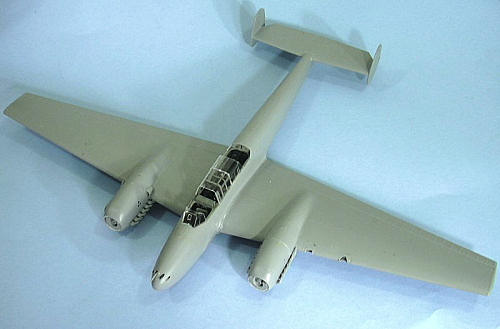 to cut off the gun barrels - they
can’t be seen anyway, and doing so will insure that the lower fuselage
center section fits when attached.
to cut off the gun barrels - they
can’t be seen anyway, and doing so will insure that the lower fuselage
center section fits when attached.
With regard to the engine
nacelles, you will need the front of the engine and the lower radiator face.
But before you do anything with those parts, you
have the problem of making the cowling side panels fit.
The rear sections of the side
panels do not fit at all without surgery.
These should be attached in position BEFORE you
proceed with further assembly of the wings, which will allow you to work
both sides of the parts to get the panels properly in position.
What I finally figured out was that the easy way is
to cut off the Dzus fasteners (which are incorrectly aligned for attachment
to the other part), and glue them in position, Then sand down the lower edge
of the rear panel, test-fitting several times, until you get it so it will
both fit and allow the other parts to fit.
Once you have the rear side
panels glued in position, then you can go ahead and assemble the wheel well
and the upper and lower wing halves.
There are no surprises here.
When that is done, assemble the
two front parts of the engine.
You will need to shim with some .010 Evergreen sheet
to get this properly centered so the props will fit correctly.
Alternatively, you could just glue the props in
place, which is certainly easier.
After you have done that, you can attach the forward
side panels.
Once you have the forward side
panels set on both sides of each nacelle, it is time to put the exhausts in.
This is tricky since there isn’t an engine inside to
glue them to.
Not only that, but the outer exhausts are molded in such a
way that they are extremely fragile and can easily break while being cut off
the sprue; the good news here is you have extras of each. The trick here in
installing these is to align them properly - they do not follow the curve of
the nacelle when seen in planview. They should be at 90-degree angles to the
wing spar, and the inner side of the rear exhaust should be about 1/16 inch
away from the side of the nacelle.
If you glue them from the inside before attaching
the rest of the cowling, this will be pretty easy.
Once that is done, you can proceed to install the
rest of the cowling and then set aside the wing sub-assemblies.
Did I mention the exhausts are pretty poor?
Dragon did manage to “drill out” the muzzles of the
nose machine guns, but these exhausts are just blocks of plastic.
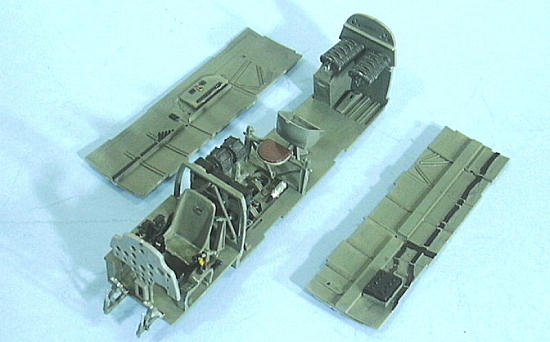 The cockpit is fairly
straightforward and mostly involves a lot of painting.
The cockpit of the Bf-110C was painted RLM02
grey-green.
I personally wish the kit had supplied instrument decals, but
the detail is raised and with care and a 4-zilch 0000 brush, you can get the
panel nicely detailed.
The cockpit is fairly
straightforward and mostly involves a lot of painting.
The cockpit of the Bf-110C was painted RLM02
grey-green.
I personally wish the kit had supplied instrument decals, but
the detail is raised and with care and a 4-zilch 0000 brush, you can get the
panel nicely detailed.
The seatbelts are nowhere near
as nicely detailed as those by Eduard, but they will look OK once they’re
installed and the model is finished.
As I said at the beginning,
shoehorning the cockpit into the fuselage is a problem.
Once you have the sie walls in position, test fit
the cockpit to the side walls and close the other fuselage half.
You may need to sand down the edges of the cockpit
floor to get things to fit.
Once it’s in position and you glue it, be very
certain that those @#$%$#@!! 20mm cannon are not sticking down out of
alignment.
Like I said - if you cut off the gun barrels you can’t see
anything when done, and this insures you have sufficient space in there to
get things to fit.
The wing spar part is the one part where you will be glad to have those gun barrels gone as you push and shove to get it in position. I found that if I cut off the locating pins for this part that it went on much easier, since the locating pins were misaligned
As regards the nose guns, it’s
a waste of time to install them as instructed, you aren’t going to see them
anyway.
My suggestion here is glue the nose cap to the fuselage -
without the interior part - once you have the fuselage all together.
Cut off the gun barrels and then install them at the
end of the project.
You will be far less likely to break them through
handling during the rest of construction that way.
Once you have the fuselage
together - and I used a lot of rubber bands here to accomplish that,
something I don’t normally do - attaching the wing and tail sub-assemblies
is easy.
My advice here is once you have that done, do not attach the aileron mass balances, the lower radio antenna or the D/F loop. By the way, there is a plastic part for the D/F loop that is far and away easier to use than the ridiculous photoetch loop assembly. The instructions don’t tell you that, but the plastic part is there if you look.
| COLORS & MARKINGS |
Painting:
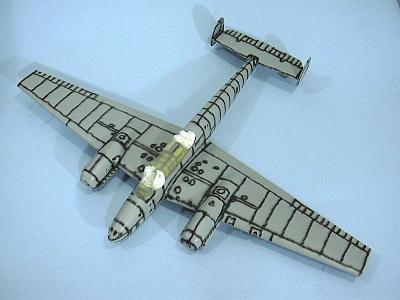 Right around the time of the
Battle of Britain, new-build Bf-110Cs started appearing in a lighter color
camouflage than the earlier 70/71 over 65 scheme.
This used RLM02 and RLM71
Dunkelgrun over the upper wing and tail, and the top of
the fuselage, with a dapple of 71/02 over the RLM65 side surfaces of the
fuselage and engine nacelles.
This is a nice-looking scheme, which I did freehand,
using Tamiya “Light Blue” for RLM65, Gunze-Sangyo RLM71, and Tamiya “German
Grey” for RLM 02.
The prop blades and the two bombs were done in
Gunze-Sangyo RLM70.
I gave the model an overall coat of Xtracrylix Gloss
Varnish to prepare for decals.
Right around the time of the
Battle of Britain, new-build Bf-110Cs started appearing in a lighter color
camouflage than the earlier 70/71 over 65 scheme.
This used RLM02 and RLM71
Dunkelgrun over the upper wing and tail, and the top of
the fuselage, with a dapple of 71/02 over the RLM65 side surfaces of the
fuselage and engine nacelles.
This is a nice-looking scheme, which I did freehand,
using Tamiya “Light Blue” for RLM65, Gunze-Sangyo RLM71, and Tamiya “German
Grey” for RLM 02.
The prop blades and the two bombs were done in
Gunze-Sangyo RLM70.
I gave the model an overall coat of Xtracrylix Gloss
Varnish to prepare for decals.
Decals
The Revell sheet for their most recent release of the old Bf-110 kit has markings for an aircraft of Erpr.Gr.210, which I used here. As I said above, these are not very good decals, and I had to replace the swastikas and lower wing crosses with decals from the dungeon. After several applications of Solvaset, the decals finally adhered to the model and I gave it a coat of Xtracrylix Gloss Varnish to seal things. I’ll say it again here: get one of the Eagle Cals sheets.
| FINAL CONSTRUCTION |
The Bf-110C-4/Bs of Erpr.Gr.210
were delivered to the unit new, and while there was a high level of
operations, I don’t think the airplanes lasted with the unit long enough to
get dinged up.
I therefore left this model clean other than to give
it exhaust stains done with Tamiya “Smoke.”
The model was given two coats of Xtracrylix Clear
Flat before I began final assembly.
Final assembly involved attaching the landing gear, the radio antennas and the D/F look, the aileron mass balances, unmasking the canopy and installing it in the open position, installing the rear machine gun, and attaching the propellers. The props and the landing gear are fairly complex sub-sub-assemblies, and look very good when completed. When all this was done, I set the model aside and breathed a big sigh of relief that this time I had beaten the Dragon, rather than the other way ‘round.
| CONCLUSIONS |
As I said at the outset, for a
kit that is such a pain in the posterior to make, the end result is a very
good-looking model indeed.
That said, the Eduard 1/48 kit (as difficult as it
is) is easier to do and also looks good when completed.
When this kit was first
announced, the price was set to be around $55.
At that price, I would not complain so loudly about
the problems this kit has, but at a price more than double that, it is to my
mind unconscionable that the manufacturer could get such
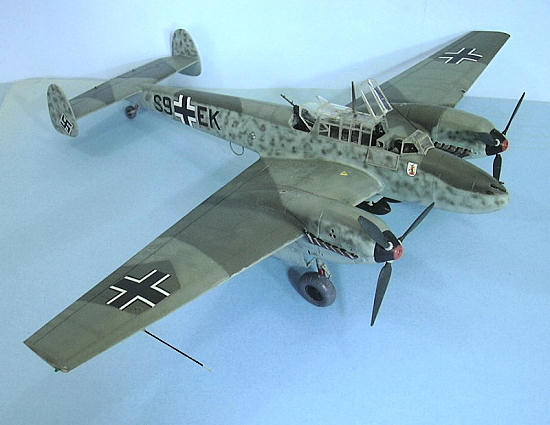 simple things as
the bloody fit so wrong!
Say what you will about Trumpeter, but at similar
prices at least things fit!! The fact that the decals are completely wrong
for this version of the airplane shows very poor research on a subject that
is far from being “rocket science.”
simple things as
the bloody fit so wrong!
Say what you will about Trumpeter, but at similar
prices at least things fit!! The fact that the decals are completely wrong
for this version of the airplane shows very poor research on a subject that
is far from being “rocket science.”
Looking at it in the box, this
model should be able to be recommended to the average guy who builds
mainstream injection-molded plastic kits and has the patience to do a
Trumpeter kit with all the parts, but with the problems this kit presents I
have to say you should be an “advanced modeler” because you are going to
have to fall back on a lot of skills developed for what should be “lesser”
kits to get this model completed.
If you follow my map to the minefield you should get
through it with less pain than I incurred, with the atmosphere over the
table only turning a light magenta on a couple of occasions.
This model is going to look
very cool sitting next to the just-arrived Revell Ju-88A-1 (a kit with its
own share of problems, I hear), and the coming Eduard Bf-109E series.
Add in the Hasegawa Spitfire I/II, and all one needs
is for Trumpeter to produce a nice scaledown of their very nice 1/24
Hurricane I to have a very nice Battle of Britain section in the collection.
Recommended to serious Luftwaffe modelers, with caveats.
Review kit courtesy of HobbyLink Japan.
December 2008
Copyright ModelingMadness.com
If you would like your product reviewed fairly and quickly, please contact the editor or see other details in the Note to Contributors.